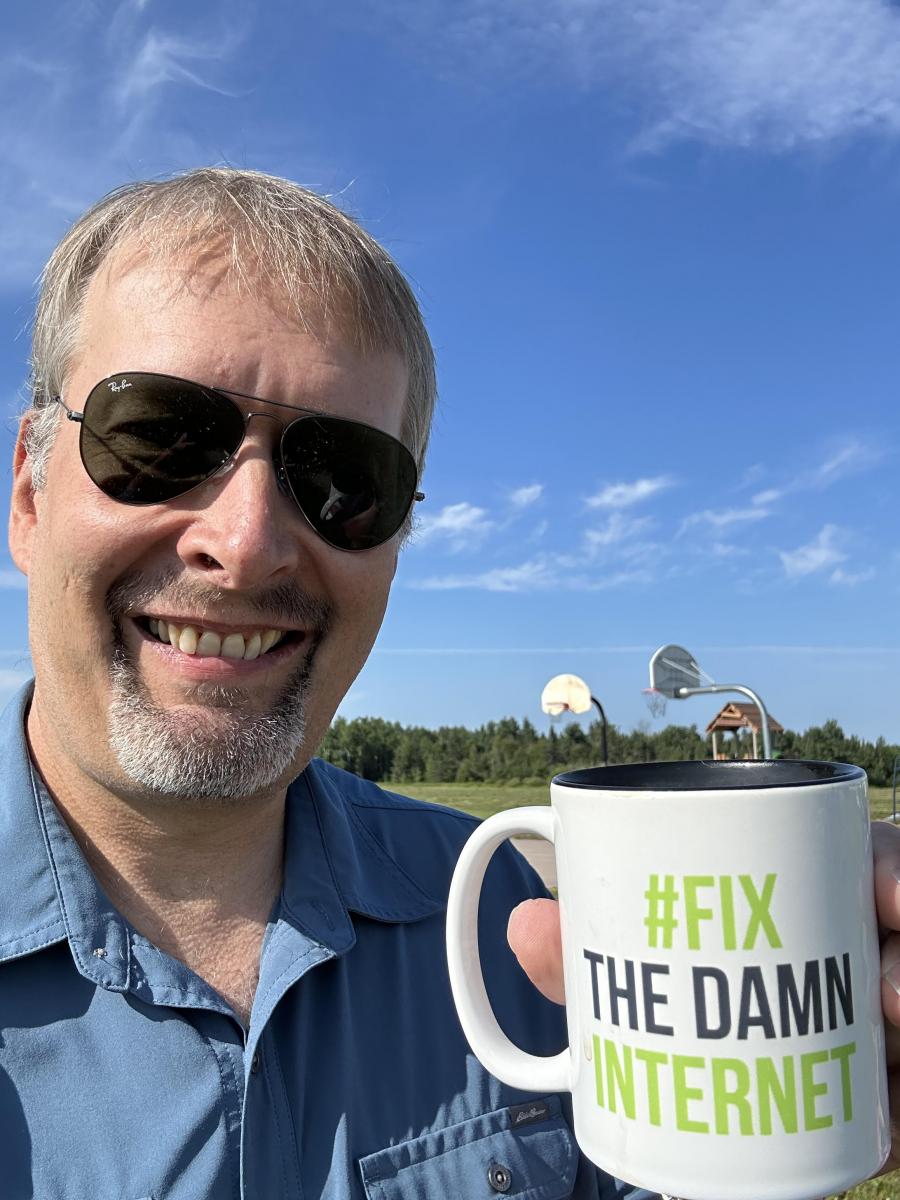The Multiplier: Connecting to Community to Connect to Networks
Thursday, October 5, 2023
Digital Beat
The Multiplier:
Connecting to Community to Connect to Networks
As more communities devise their own broadband solutions, leveraging the upcoming funding from the Infrastructure Investment and Jobs Act, what makes for successful efforts that are responsive to community needs? This is the third of six case studies that seek to understand the stories of broadband community champions and the factors that contributed to their success. A final analysis will identify the characteristics of effective broadband leaders, and develop a taxonomy of those working to improve broadband access in their communities in official and unofficial capacities. This research is supported by the Marjorie & Charles Benton Opportunity Fund.

Jason Kronemeyer, the Director of Technology at Eastern Upper Peninsula Intermediate School District (EUPISD), has been relentlessly working towards enhancing educational outcomes in the region. Along the way, he grew into the role of a broadband champion. Jason's fervent desire to accelerate student learning, coupled with unconventional strategies of “connecting the dots” over decades have played an essential role in attracting infrastructure construction and driving broadband adoption. His dedicated efforts have contributed to millions in infrastructure grant awards, and has attracted multiple internet service providers (ISPs) to the Eastern Upper Peninsula.
Inspiration and Inception
The Eastern Upper Peninsula (EUP) in Northern Michigan encompasses Mackinac, Chippewa, and Luce Counties and is home to 53,000 residents, nearly half of them live below the ALICE poverty line. For years, this extremely rural region's progress and educational opportunities have been hindered by the scarcity of broadband infrastructure and limited internet service providers (ISPs).
EUPISD began working to leverage the internet to improve education in 1992 when a distance learning project commenced that connected all the high schools with a fiber cable modem that allowed up to three remote classrooms at a time to connect. Jason was hired in 1999 as a computer technician on this network, and the power of connectivity for education resonated with this introductory experience.
“I was inspired early on. I could see the promise of what access to the internet really meant—a self-directed learner could know anything they wanted,” he said. Encouraged by this initial revelation, Jason spent the remainder of his career devising creative solutions to connect students to broadband both in and outside of the classroom.
While previous broadband champions in this series of case studies have led by marshaling forces and resources in their community, Jason’s strategy has been distinctly different—identifying opportunities to attract new providers, creating demand in the community, and storytelling through data. Jason’s efforts have culminated in tens of millions in infrastructure grant awards and expanded service provider options in the EUP.
Connectivity as a Calling
Jason is convinced that broadband access significantly boosts students’ learning speed and capacity. His desire to enhance educational results fuels his dedication to expanding internet connectivity throughout the community—something that stretches beyond his official role at the ISD, which ends at the school premises. According to Jason, “Connectivity at the schools—that’s a job responsibility. Connectivity in our students’ homes is my personal responsibility.”

The cornerstone of these endeavors, Jason points out, is cultivating and inspiring strong relationships. Growing up on a dairy farm, Jason's parents instilled in him the significance of community involvement, being an active member of the church, and contributing to your industry. "Building relationships involves assisting others. If you support others, they'll in turn help you when you need it.” In leadership, he notes, this principle is known as "multiplying." To effectively connect the community, Jason connects TO the community, by multiplying through educating others, communicating, and inspiring neighbors to action.
As a part of his strategy to increase community need for the internet and reduce barriers for new ISPs, Jason saw the National Telecommunications Information Administration’s Broadband Technology Opportunities Program (BTOP) as an opportunity to create initial market demand for students’ home broadband access. “We knew that we had to increase demand for the internet; otherwise nobody was going to build it,” Jason said. In 2010, EUPISD’s BTOP application was successful and NTIA awarded the district $3.8 million to purchase computers for every 7th-12th grader. However, while every student now had a computer, large swaths of the community had no available internet service. Tom McKee, Superintendent of Rudyard Area School District, recalled this in a 2019 video interview, “It’s like we bought a brand new vehicle for every kid to access what they need to, but we don’t have the gas to get them there.”
Frustrated with the lack of practical steps in national models for community action plans, Jason then turned his attention to service availability. He worked to address the issue in a more coordinated manner through cooperative partnerships with regional planning groups. “All the guidance was focused on population centers—there wasn’t a broad conversation about grasping what the barriers were in areas like ours.”
Educating others has been key to expanding this availability. As a data scientist and consummate learner, Jason recognized the power of data for telling the story of the essentiality of home internet for students in the EUP to potential service providers and grant funders. He has continually leaned on community sentiment and infrastructure data as a storytelling mechanism to support grant narratives and attract providers. Jason actively pursues research collaborations to shed light on the detrimental effects of internet absence on students' academic trajectories, future prospects, and societal integration.
Regional Planning and the EUPConnect Collaborative
In an effort to better understand the digital divide, Jason partnered with the EUP regional planning group in household demand and service availability survey efforts from 2013-2016. In 2018, Jason led the EUP Broadband Infrastructure planning initiative with funding from the EDA. As a part of this effort, the EUPISD and the regional planning and development group identified more than 200 strategic community anchor locations throughout the EUP to interconnect with high-speed, secure infrastructure.
“We gathered hundreds of key facilities across the EUP and made an infrastructure plan to work towards interconnecting all of those points. You can reduce the capital investment that is needed by an ISP to extend their networks through the last miles by connecting these dots for them,” Jason noted.
Also in 2018, the Quello Center for Media and Information Policy conducted a pilot study in collaboration with EUPISD to measure rates of home connectivity among students and investigate the relationship between connectivity and student performance among 15 rural school districts. Jason was a member of the focus groups that designed the pilot study. This research showed that students who did not have access to the internet at home performed lower on a range of metrics, such as homework completion, grade point average, standardized test scores, and interest in STEM-related careers. In 2019, Merit Network conducted a follow-up investigation on the effects of limited broadband access on educational results in Michigan's Eastern Upper Peninsula through video interviews to complement the Quello study. Jason also championed a citizen-scientist survey and speed test investigation in partnership with Merit’s Michigan Moonshot in 2022 in order to support access expansion planning. This study found that only 22 percent of all residents had access to the internet at broadband speeds and 29 percent of survey respondents with school-aged children in the home had access to broadband internet. From Jason's perspective, these studies that educated the public about students’ needs, along with the compelling narratives communicated via video testimonials, marked a watershed moment in drawing public focus to the infrastructural void in the region.
Relationship building, connecting others, and Jason’s approach to “multiplying via educating others” were critical in instigating community action. Just as indispensable was his approach to facilitating discussion and communicating with residents, service providers, and organizations within the region. In response to the American Rescue Plan Act (ARPA) funding availability, Jason facilitated the development of the EUPConnect Collaborative in 2021. “Everyone is trying to do it on their own—this is a causal factor of the digital divide,” Jason said. “I solve problems by getting the right people in a room to talk together.” More than 45 K-12 entities, higher education organizations, local units of government, healthcare organizations, and others pooled portions of their ARPA allocations in order to jointly address the lack of available service in the EUP. The collaborative’s goal is to achieve connectivity to every 911 service address with speeds of 1 Gbps minimum fixed broadband service for all residents. The EUPConnect Collaborative communicates the progress of their strategic initiatives with the community through webinars, videos, economic reports, and a blog.
A Champion’s Legacy
Jason’s work has been instrumental in five major infrastructure investments in the region totaling approximately $67 million; including an Economic Development Administration (EDA) grant under the Coronavirus Aid, Relief, and Economic Security (CARES) Act to support construction of 70 miles of middle-mile fiber optic infrastructure in the Upper Peninsula in 2022 (won by Merit Network and EUPConnect Collaborative together), a Rural Digital Opportunity Fund award from the Federal Communications Commission in 2021 to Highline Internet, three U.S. Department of Agriculture ReConnect grant applications that were awarded in 2023, in addition to significant private investment. The EUPConnect Collaborative has also pooled more than $750,000 to support community goals of connecting every 911 service address.
The Quello Center conducted a follow-up homework gap study in the EUP that found a reduction in both the number of students with no internet access and the number of students dependent upon cell phones for internet access.
Despite these improvements, much work remains in the EUP. “We still have a huge need for middle-mile, and many of our schools are still connecting to the internet on a metered capacity,” said Jason. Jason has encouraged the schools to leverage the federal E-Rate program to improve connectivity. To Jason, E-Rate presents the greatest opportunities for schools and libraries to close the digital divide by supporting middle-mile buildouts in coordination with other investments, such as BEAD.
Jason recently disclosed his plans to retire in the near future. As he reflects on his career, his achievements in the Eastern Upper Peninsula are entwined with a measure of regret. "I'm into the second half of my 25th year, and it seems like we’re just getting started," he remarked. Jason strongly believes his ability to educate, communicate and inspire has had a substantial influence and empowered students to excel. "I'm confident that I've made a significant impact, and I hope that my successor will be as deeply committed to the community as I have been," he added.
For more see:
- Hampton, K. N., Fernandez, L., Robertson, C. T., & Bauer, J. M. Broadband and Student Performance Gaps. James H. and Mary B. Quello Center, Michigan State University.
- Hampton, K. N., Hales, G.E., & Bauer, J. M. (2023). Broadband and Student Performance Gaps After the COVID-19 Pandemic. James H. and Mary B. Quello Center, Michigan State University.
- Broadband and Student Performance Gaps, 2020
- Michigan Moonshot Homework Gap Video Testimonials
See more in this series:
- A Passion for Community Drives Broadband Forward in Holland, Michigan
- Building Broadband Momentum in Berrien County
Dr. Pierrette Renee Dagg, Ph.D is a Benton Institute Digital Opportunity Fund Fellow, the Director of Technology Impact Research at Merit Network. The aim of her work is to bridge the gap between academic scholarship and practical application to advance issues of technology understanding and information equity.
The Benton Institute for Broadband & Society is a non-profit organization dedicated to ensuring that all people in the U.S. have access to competitive, High-Performance Broadband regardless of where they live or who they are. We believe communication policy - rooted in the values of access, equity, and diversity - has the power to deliver new opportunities and strengthen communities.
© Benton Institute for Broadband & Society 2023. Redistribution of this email publication - both internally and externally - is encouraged if it includes this copyright statement.
For subscribe/unsubscribe info, please email headlinesATbentonDOTorg






